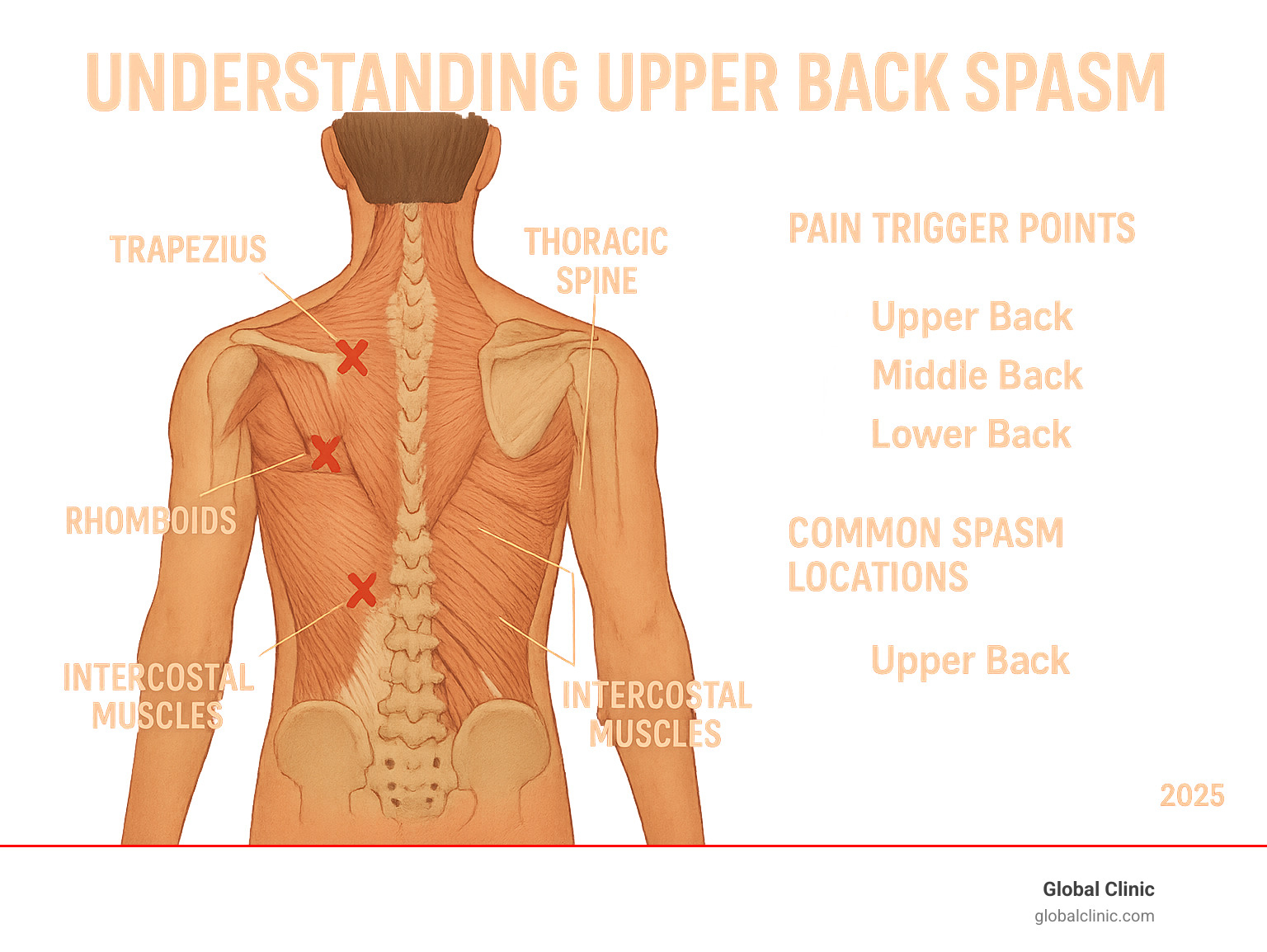Why Understanding Back Spasms Can Transform Your Pain Management Journey
An upper back spasm is a sudden, involuntary muscle contraction that can range from a mild twitch to debilitating pain that stops you in your tracks. Here’s what you need to know:
For a broader overview of how and why spasms occur, see muscle spasm.
What is an upper back spasm?
- Sudden tightening of muscles in the thoracic spine region
- Can cause sharp, stabbing pain or dull, cramping sensations
- Often creates a “knot” or tight feeling between shoulder blades
- May radiate to neck, shoulders, or arms
Common causes include:
- Poor posture from hours spent hunched over a desk or looking down at a phone, a phenomenon often called “tech neck.”
- Overuse from repetitive activities like painting a ceiling, a new and intense workout routine, or even vigorous coughing.
- Stress and anxiety triggering your body’s “fight or flight” response, which causes muscles to tense up in preparation for a perceived threat.
- Dehydration or nutritional deficiencies, especially a lack of electrolytes like potassium, calcium, and magnesium, which are crucial for proper muscle function.
- Underlying conditions like herniated discs or arthritis
When to seek help:
- Pain persists more than a few days
- Accompanied by numbness, weakness, or tingling
- Severe pain that limits daily activities
- Recurring episodes that worsen over time
Back spasms affect up to 20% of women and 10% of men at some point in their lives. While the thoracic spine is naturally more stable than your neck or lower back due to its connection with the rib cage, when spasms do occur in this region, they can significantly impact your breathing, posture, and overall quality of life. Simple acts like taking a deep breath, turning to look over your shoulder, or even sitting comfortably can become a painful ordeal.
The good news? Most upper back spasms respond well to proper treatment and prevention strategies. Understanding what’s happening in your body is the first step toward finding lasting relief.
I’m Ana Vinikov, and through my work at Global Pain & Spine Clinic, I’ve helped countless Northern Chicago patients overcome upper back spasm episodes using our comprehensive, non-surgical approach. My experience has shown me that a one-size-fits-all approach simply doesn’t work. Addressing both the immediate symptoms and the unique underlying causes for each patient is what leads to the most successful, long-term outcomes.

Understanding the Anatomy of a Back Spasm
Think of a muscle spasm as your body’s overprotective security guard. When something feels wrong, this “guard” suddenly clamps down hard, creating an involuntary muscle contraction that refuses to let go. Unlike a simple muscle twitch you might get in your eyelid, an upper back spasm is intense and persistent – your muscle essentially locks up to prevent what it perceives as further injury.
This is quite different from a muscle strain, which is actual damage to the muscle fibers themselves. While a strain can certainly trigger a spasm, the spasm is really your body’s protective response. It’s like the difference between breaking your arm and having someone grab it tightly to keep it still.
Your upper back has a unique advantage when it comes to stability. The thoracic spine – that’s the technical name for your upper back – consists of 12 vertebrae that connect directly to your rib cage. This creates a natural “cage” around your heart and lungs, making this area much more stable than your neck or lower back.
Because of this built-in stability, upper back spasms are actually less common than those pesky neck cricks or lower back episodes. But when they do happen, they can be particularly uncomfortable because they can affect your breathing and posture.
When a spasm strikes, the pain rarely stays put. This radiating pain is like ripples in a pond – it starts at the spasm site but can travel to your neck, shoulders, or even down your arms. It’s your body’s interconnected network of muscles and nerves sending distress signals far and wide.
To help you understand how different areas of your back behave, here’s what makes each region unique:
| Back Region | Location | Common Causes | Radiating Pain Patterns |
|---|---|---|---|
| Upper Back | Between shoulder blades, thoracic spine | Poor posture, “tech neck,” stress, sudden movements | Neck, shoulders, arms, chest |
| Middle Back | Lower thoracic, upper lumbar region | Heavy lifting, twisting motions, prolonged sitting | Sides, around ribs, lower back |
| Lower Back | Lumbar spine, sacral area | Heavy lifting, prolonged sitting, weak core muscles | Hips, buttocks, legs, feet |
The key thing to remember is that your upper back spasm isn’t just a simple muscle problem – it’s part of a complex system that includes your spine, ribs, and the intricate web of muscles that keep you upright and moving. Understanding this helps explain why the right treatment approach matters so much for lasting relief.
What Does a Spasm Feel Like?
If you’ve never experienced an upper back spasm, consider yourself lucky. If you have, you know exactly what we’re talking about. The sensation can vary from person to person, but there are some telltale signs that you’re dealing with a spasm rather than regular muscle soreness.
Sharp, stabbing pain is often the first sign. It can hit suddenly – maybe you turned to grab something from your car’s backseat, or you woke up and stretched the wrong way. This pain feels different from the dull ache of overworked muscles after a tough workout.
Many people describe feeling like they have a tight knot between their shoulder blades. It’s as if someone tied a rope around your muscles and pulled it as tight as possible. You might find yourself reaching back, trying to massage or press on the spot, but it feels rock-hard and unyielding under your fingers.
Cramping sensations are another common experience. Your muscle feels like it’s seized up and won’t release, similar to a leg cramp but in your back. Unlike a leg cramp that might release when you stretch, back spasms can be stubbornly persistent.
The stiffness that comes with spasms can be surprising in its intensity. You might find that simple movements like turning your head or reaching for something become difficult or impossible. Your body naturally tries to protect the area by limiting movement.
Pain with breathing is particularly common with upper back spasms because of how connected your back muscles, particularly the intercostal muscles between your ribs, are to your rib cage. Each inhalation expands the ribs, stretching these tight muscles and triggering a sharp response. You might notice yourself taking shallower breaths to avoid triggering more pain.
Some people also experience numbness or tingling that can extend into their arms or hands. This happens when the muscle spasm puts pressure on nearby nerves, creating that “pins and needles” feeling. This is a crucial symptom to monitor, as it indicates the spasm may be compressing or irritating a nearby nerve. If this sensation persists or is accompanied by weakness, it’s a clear sign to seek professional medical advice.
How Spasms Differ from Other Back Pain
Not all back pain is created equal, and understanding the difference can help you get the right treatment faster. Muscle pain from spasms feels tight, cramped, and localized to the muscle itself. It’s often described as a deep, unyielding ache or a hard knot that you can feel with your fingers. In contrast, nerve pain tends to be more of a shooting, burning, or electric sensation that travels along specific pathways, like the sharp pain that runs down the leg with sciatica.
Disc issues create their own unique signature. If you have a herniated or bulging disc, you might feel pain that’s deep and aching, often worse when you sit or bend forward because these positions increase pressure on the affected disc, causing it to bulge further and press on spinal nerves. This is quite different from the tight, knotted feeling of a muscle spasm.
In contrast, arthritis pain in your back tends to be more of a constant, grinding discomfort that gets worse with activity and better with rest. This is often due to the breakdown of cartilage in the spinal joints, and it’s usually accompanied by morning stiffness that improves as you move around during the day.
The timing matters too. Acute pain from a spasm often comes on suddenly and intensely, while chronic pain from conditions like arthritis develops gradually and persists over time.
Sometimes, what feels like back pain isn’t actually coming from your back at all. Referred pain from issues like gallstones or kidney problems can masquerade as back pain. This is why persistent or severe pain should always be evaluated by a healthcare professional.
It’s worth noting that conditions like Piriformis Syndrome vs. Sciatica can also create confusing pain patterns that might be mistaken for back spasms, especially when the pain radiates down your leg.
The key is paying attention to your body’s signals and getting proper evaluation when something doesn’t feel right. At Global Clinic, we’ve seen how the right diagnosis can make all the difference in getting you back to feeling your best.


